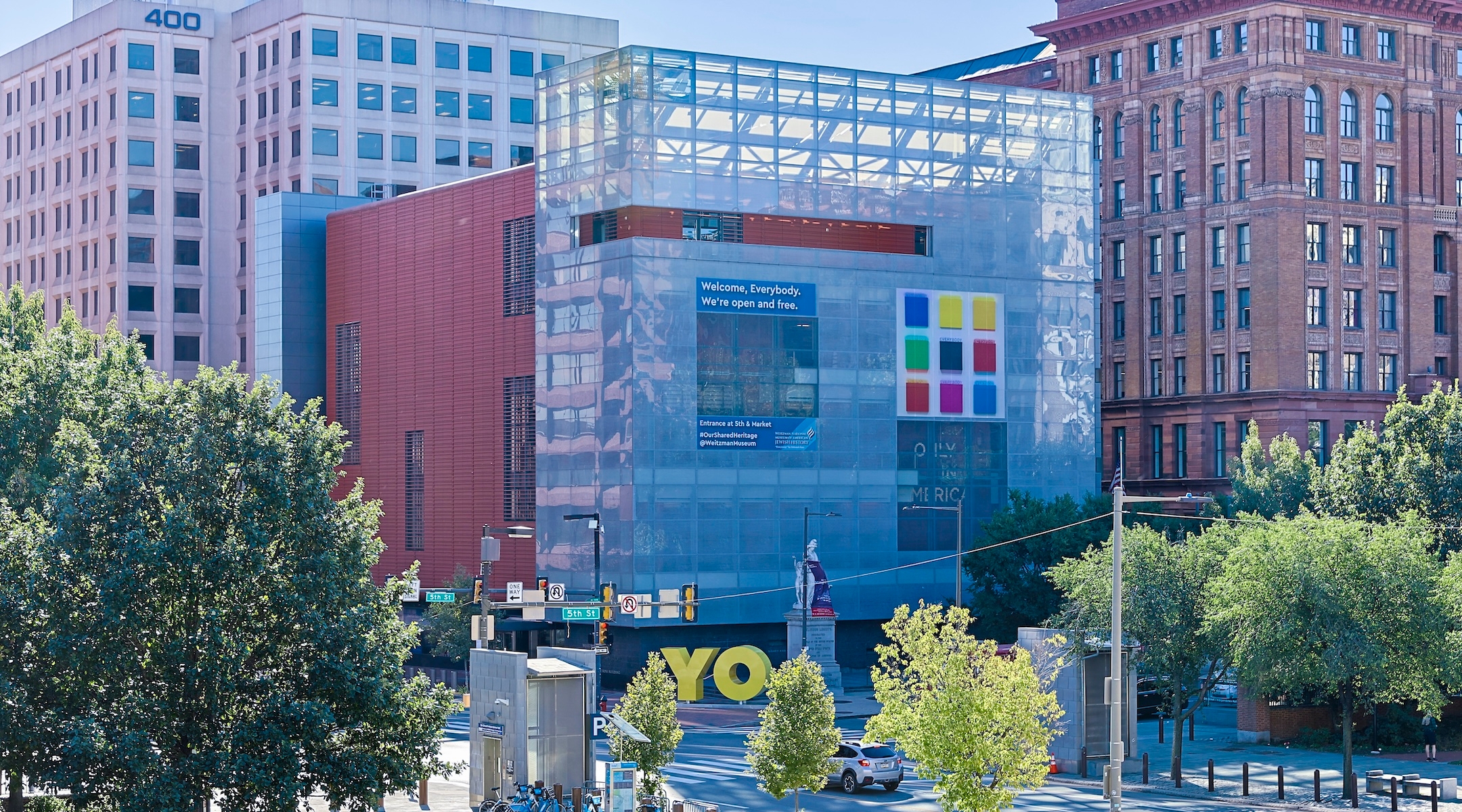Why the Weitzman, a museum of American Jewish history, tapped an Israeli as its next CEO
Dan Tadmor recently led Tel Aviv’s ANU – Museum of the Jewish People through a successful $100 million renovation

A view of the National Museum of American Jewish History in Philadelphia (Shoot from WIthin)
(JTA) — Full of lofty ambitions, a museum focused on American Jews has put its faith in a new leader who comes from Israel.
The reason that Philadelphia’s Weitzman National Museum of American Jewish History trusts Dan Tadmor to elevate the institution’s profile over the coming years is that he recently finished doing something similar at his old job.
Tadmor, who was announced Tuesday as Weitzman’s next CEO, oversaw the $100 million transformation of a Tel Aviv museum called Beit Hatfutsot, which reopened in 2021 as ANU-Museum of the Jewish People, almost instantly becoming one of Israel’s most prominent and celebrated cultural landmarks. From a narrative emphasizing the separation of the Diaspora from Israeli Jewry, the museum pivoted to a message of unity of Jewish communities across the globe.
The vision for the Weitzman, a 48-year-old institution located in an architecturally significant building on Philadelphia’s Independence Mall — but away from the largest concentration of American Jews, in New York City — is complex.
The museum wants upgrades to put it at the cutting edge of curatorial technology while expanding its role as a national center for Jewish life. Most importantly, the museum sees a purpose for itself in examining the dramatic changes underway in society, including the resurgence of antisemitism many had believed was largely relegated to the past.
“At a time when the cultural landscape is rapidly changing, a museum like the Weitzman needs to expand and rethink the way that it tells the American Jewish story and the Jewish story in general,” Tadmor said in an interview.
Museum leaders believe the Weitzman is especially suited for the task of countering antisemitism in the United States, which is reflected in the hiring of Dara Horn as a creative advisor. Horn argues that efforts to sensitize the public by educating it about the Holocaust and historical Jewish plight have backfired. Instead, she advocates a focus on teaching the public about the vibrancy of the present-day Jewish community.
As Tadmor courts donors and revamps exhibitions, he’ll be under an even larger spotlight than what’s typical for a new museum leader. That’s because the Weitzman is in the midst of an audition of sorts: it’s under consideration to become a member of the Smithsonian, a decision that requires congressional involvement.
As an example of what’s changing, Tadmor spoke of how his thinking on antisemitism has been upended.
“If you’d have asked me several years ago, I honestly thought that antisemitism, for the most part, was a relic of the past, something that’s almost disappearing,” he said. “It’s not what I think now. And by the way, this isn’t just post-Oct. 7. Antisemitism was on the rise all over the world, including the United States, way before Oct. 7.”
Tadmor’s selection has come with a raft of public endorsements by prominent Jewish figures from historian Jonathan Sarna to Rabbi Angela Buchdahl.
“At a moment when American Jews of all ages are looking to reimagine their place within the American landscape, Dan Tadmor will know how to guide The Weitzman as it looks to meet the challenges of the moment and to prepare a generation of young Jews for the future,” Sarna said in a statement.
A native Israeli, Tadmor spent 12 years helming ANU and before that, he held top executive positions in Israeli print media and television. But already as a child, he gained experience that would help prepare him to lead an institution dedicated to American Jews. Tadmor lived in the United States in the 1970s from ages 9 to 13 when his father, Shlomo Tadmor, was Israel’s consul general in San Francisco.
“That’s where I picked up my English, my second language — and my second culture,” he said, speaking with almost no discernible Israeli accent.
He’s also spent much of his professional life making connections between the United States and Israel, first as a television executive responsible for bringing American productions to Israel, and then through ANU, which devotes significant attention to American Jewry in its exhibits and has collaborated with the Weitzman on educational initiatives and exhibitions.
“I’m very much familiar with the subject matter, but also I’m ashamed to say that most of the funding for ANU came from North America,” he said.
Whether he manages to replicate the fundraising success of ANU is an open question, especially given a challenging environment for at least some Jewish museums. The Weitzman declared bankruptcy before being rescued in 2021 by footwear entrepreneur Stuart Weitzman, after whom the museum was renamed. San Francisco’s Contemporary Jewish Museum announced last week that it would close for at least a year, in part because of a drop in donations.
The San Francisco museum had 34,000 visitors during the most recent fiscal year for which public information is available, the year ending in June 2023. The Weitzman had 40,000 visitors during that time.
Becoming a Smithsonian institution would unlock a stream of federal government funding.
A message from our CEO & publisher Rachel Fishman Feddersen
I hope you appreciated this article. Before you go, I’d like to ask you to please support the Forward’s award-winning, nonprofit journalism during this critical time.
We’ve set a goal to raise $260,000 by December 31. That’s an ambitious goal, but one that will give us the resources we need to invest in the high quality news, opinion, analysis and cultural coverage that isn’t available anywhere else.
If you feel inspired to make an impact, now is the time to give something back. Join us as a member at your most generous level.
— Rachel Fishman Feddersen, Publisher and CEO